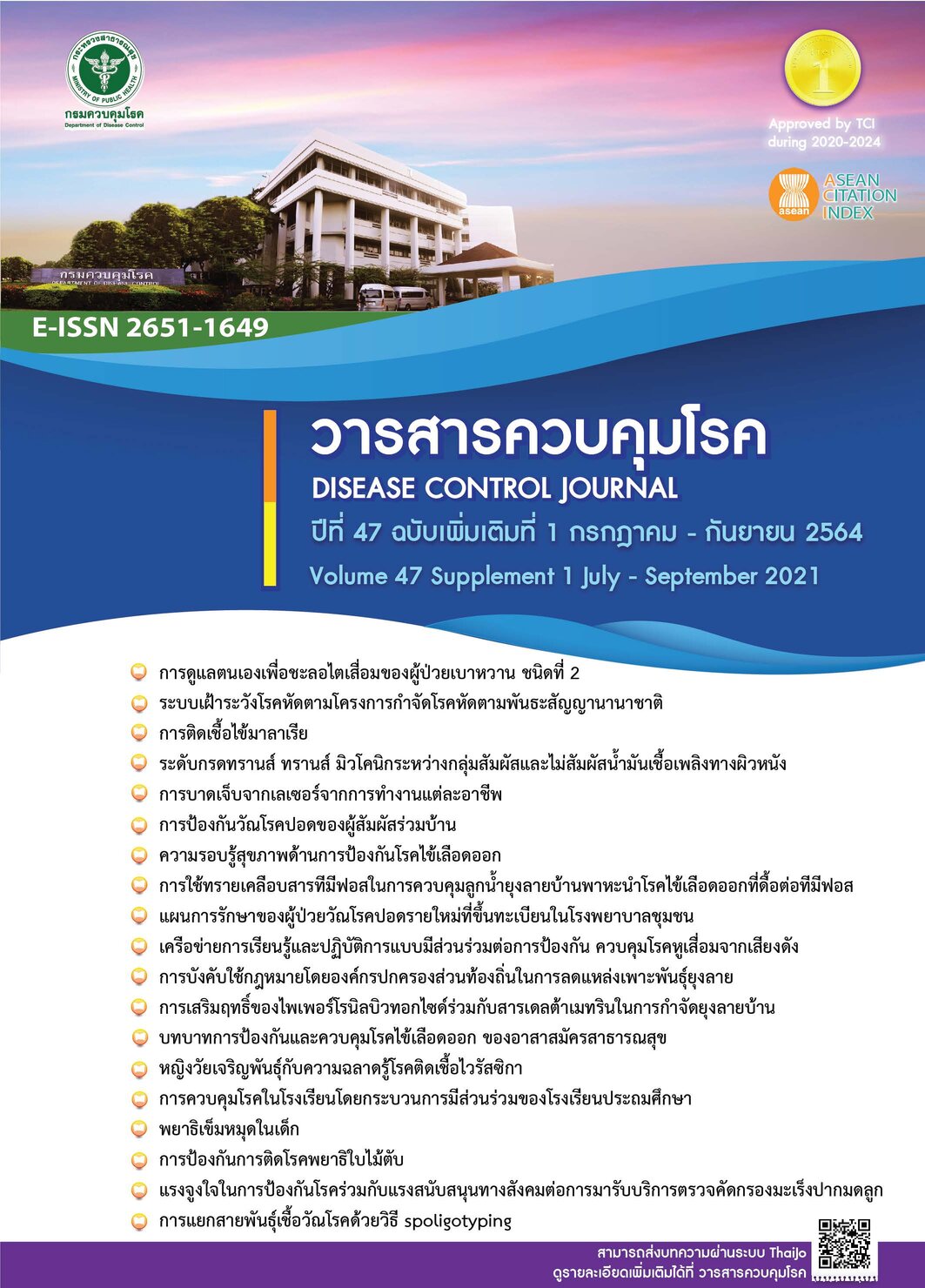Factors related to malaria infection among people in border communities in Mae Sariang district, Mae Hong Son province
DOI:
https://doi.org/10.14456/dcj.2021.60Keywords:
Risk Factors, Malaria infection, Thai-Myanmar borderAbstract
The objective of this case-control study was to determine risk of malaria infection of people resided along the Thai-Myanmar border of Mae Sariang district, Mae Hong Son Province. Cases comprised of 96 infected malaria and control was 192 non- malaria infected who came to get the service from 4 health promoting hospitals of Mae Sariang District from October 2016 to September 2017. Face-to-face interview using structured questionnaire from all studied participants was performed for data collection. The following descriptive statistics: number, percent, mean, standard deviation, minimum, maximum, simple and multiple binary logistic regression analysis at a significance level of 5% were applied for the analysis. The results showed that; males were at higher risk of malaria infection than females (AOR=2.42, 95% CI=1.33-4.42). People with monthly incomes of 3,000 baht or more were more likely to have malaria infection than those earning less than 3,000 baht a month (AOR=2.32, 95% CI=1.07-5.049). Those who had traveled to camp outside their residential areas were more risky than those who had never camped outside their residential areas (AOR=2.23, 95% CI=1.34-3.70). Those who camp or live in risk areas more likely to be at risk than those who had never camped or lived in a high-risk area (AOR=4.76, 95%CI=2.51-9.03). And those who are not clothed to cover their bodies they were more at risk than those who wore clothing to cover their bodies (AOR=4.81, 95%CI=2.00-11.57). People living along Thai-Myanmar border are suggested to focus on taking care of them self and family members on wearing clothes that cover the body completely whenever staying overnight outside the residential area or enter the risky area including changing behaviors to prevent and control malaria, such as sleeping in mosquito nets, using anti-mosquito materials such as chemicals or herbs.
Downloads
References
Niamnuy N. Malaria. Journal of the medical technologist. 2012;40(3):4289-98.
Division of Vector Born Disease. Annual report 2015. Nonthaburi: Division of Vector Born Disease; 2015.
Division of Vector Born Disease. Thailand malaria elimination program [Internet]. 2016 [cited 2020 Apr 19]. Available from: http://malaria.ddc.moph.go.th/malariaR10/index_v2.php
Vector Born Disease Control Unit 1.1.4 Maesariang, Mae Hong Son province. Annual report. Vector Born Disease Control Unit 1.1.4 Maesariang; 2017.
Kumbanchat Y, Jirapornkul Ch, Tungsrithong N. Factors in association with malaria infection in Phu Phan district, Sakon Nakhon province, Thailand. KKU Journal for public health research. 2015;8(4):57-64. (in Thai)
Pradit P. Meta analysis of factors associated with malaria prevention behavioral to follow
the health belief model and social support theory (dissertation). Bangkok: Thammasat University; 2015. 160 p. (in Thai)
Hanbungkla S, Charerntanyarak L. Factors associated with malaria infection of endemic area in 2015, Ratchaburi province. Disease Control Journal. 2017;43(4):423-35. (in Thai)
Lapyai D. Relevance of climate change on malaria transmission in Pha Bong Sub-district, Mueang District, Mae Hong Son province (dissertation). Chiang Mai: Chiang Mai University; 2018. 180 p. (in Thai)
Srichuen R. Risk factors of malaria infection in Thai-Myanmar border Ranong Province, Thailand (dissertation). Khon Kaen: Khon Kaen University; 2005. 125 p. (in Thai)
Chirebvu E, Chimbari MJ, Ngwenya BN. Assessment of risk factors associated with malaria transmission in Tubu Village, Northern Bostswana. Malaria research and treatment [Internet]. 2014 [cited 2017 Nov 10]. 21 p. Available from: https://europepmc.org/article/med/24757573.
Maneedang P, Rongmuang D, Thongphet P, Sridowruang C. Lifestyle, lack of knowledge,
beliefs and wrong health behavior cause malaria among burmese workers in Sai Dang Sub- district, Muang Ranong. The southern college network journal of nursing and public health. 2016;3(3):77-93.
Downloads
Published
How to Cite
Issue
Section
License
Articles published in the Disease Control Journal are considered as academic work, research or analysis of the personal opinion of the authors, not the opinion of the Thailand Department of Disease Control or editorial team. The authors must be responsible for their articles.






